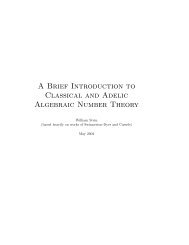COMPUTATIONAL VERIFICATION OF THE BIRCH ... - William Stein
COMPUTATIONAL VERIFICATION OF THE BIRCH ... - William Stein
COMPUTATIONAL VERIFICATION OF THE BIRCH ... - William Stein
Create successful ePaper yourself
Turn your PDF publications into a flip-book with our unique Google optimized e-Paper software.
12 GRIGOROV, JORZA, PATRIKIS, STEIN, AND TARNIT¸ Ǎ-PǍTRAS¸CU<br />
3.4. Mordell-Weil Groups and Quadratic Imaginary Fields. Let E be an<br />
elliptic curve over Q and K = Q( √ D) a quadratic imaginary field such that E(K)<br />
has rank 1. In this section we explain how to understand E(K) in terms of E(Q)<br />
and E D (Q).<br />
The following proposition is well known, but we were unable to find a reference.<br />
Proposition 3.15. Let R = Z[1/2] and K = Q( √ D). For any squarefree integer<br />
D = 1, we have<br />
E(K) ⊗ R = (E(Q) ⊗ R) ⊕ (E D (Q) ⊗ R).<br />
Proof. Let τ be the complex conjugation automorphism on E(K) ⊗ R. The characteristic<br />
polynomial of τ is x 2 − 1, which is squarefree, so E(K) ⊗ R is a direct<br />
sum of its +1 and −1 eigenspaces for τ. The natural map E(Q) ↩→ E(K) identifies<br />
E(Q) ⊗ R with the +1 eigenspace for τ since E(K) GQ = E(Q); likewise,<br />
E D (Q) ↩→ E(K) identifies E D (Q) ⊗ R with the −1 eigenspace for τ. <br />
The following slightly more refined proposition will be important for certain<br />
explicit Heegner point computations (directly after Equation (3.4)).<br />
Proposition 3.16. Suppose E(K) has rank 1. Then the image of either E(Q) / tor<br />
or E D (Q) / tor has index at most 2 in E(K) / tor.<br />
Proof. Since E(K) has rank 1, Proposition 3.15 implies that exactly one of E(Q)<br />
and E D (Q) has rank 1 and the other has rank 0. We may assume that E(Q) has<br />
rank 1 (otherwise, swap E and E D ). Let i be the natural inclusion E(Q) ↩→ E(K),<br />
and let τ denote the automorphism of E(K) induced by complex conjugation. Then<br />
P ↦→ (1 + τ)P induces a map E(K) → E(K) + = E(Q) that, upon taking quotients<br />
by torsion, induces a map ψ : E(K) / tor → E(Q) / tor. Let P1 be a generator for<br />
E(Q) / tor and P2 a generator for E(K) / tor, and write i(P1) = nP2, for some nonzero<br />
integer n. Then<br />
[2]P1 = ψ(i(P1)) = ψ(nP2) = [n]ψ(P2) = [nm]P1 (mod E(Q)tor),<br />
for some nonzero integer m. Thus 2 = nm, so n ≤ 2. <br />
The root number εE = ±1 of E is the sign of the functional equation of L(E, s).<br />
If εE = +1, then the analytic rank ords=1 L(E, s) is even, and if εE = −1, then it<br />
is odd.<br />
Proposition 3.17. Let E be an elliptic curve, let D = DK be a discriminant that<br />
satisfies the Heegner hypothesis such that ords=1 L(E/K, s) = 1, and let R = Z[1/2].<br />
Then<br />
(1) If εE = +1, then a generator of E(K) ⊗ R is the image of a generator of<br />
E D (Q) ⊗ R and L ′ (E/K, 1) = L(E, 1) · L ′ (E D , 1).<br />
(2) If εE = −1, then a generator of E(K) ⊗ R is the image of a generator of<br />
E(Q) ⊗ R and L ′ (E/K, 1) = L ′ (E, 1) · L(E D , 1).<br />
Proof. Since D satisfies the Heegner hypothesis, by computing the residue symbol<br />
N and taking into account how the sign of the functional equation changes under<br />
D<br />
twist, we see that<br />
The factorization<br />
ords=1 L(E, s) ≡ ords=1 L(E (D) , s) (mod 2).<br />
L(E/K, s) = L(E/Q, s) · L(E D /Q, s),
















